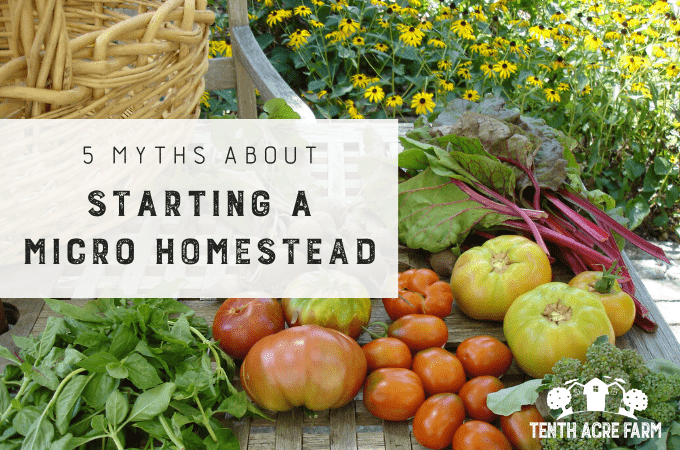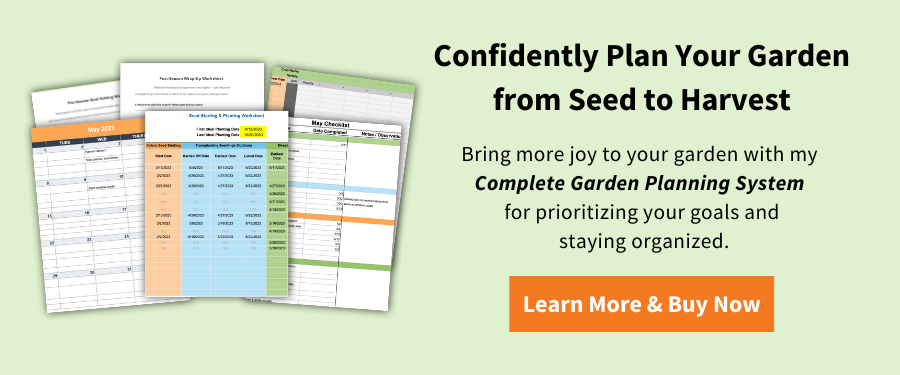5 Myths about Starting a Micro Homestead
Would you like to grow food for your family on your own micro homestead? What’s stopping you? Here are five myths that keep you from getting started.


This page may contain affiliate links. Please read my disclosure for more info.
When it comes to starting your own micro homestead garden, there’s no shortage of excuses. Believe me, I know! It took me a few years to get started because I was afraid of making mistakes or sticking out like a sore thumb in my neighborhood. I had lots of ideas of what I wanted my micro homestead to be like, but when I thought about getting started, I felt overwhelmed.
When something seems overwhelming, we procrastinate. Even if it’s something we really want. (Like that exercise program I paid for months ago and haven’t started yet!)
Here are five misconceptions that—if we believe them—can keep us from having our very own micro homestead.
Ready? Let’s tackle these one by one.
Myth 1: You need a lot of space to have a micro homestead garden.
One hot August Saturday, I was working in my little homestead garden, harvesting bushels of fruits and vegetables. My neighbor watched my work and quipped, “I wish I could have a garden. I used to have a garden when I lived in the country.”
Maybe she didn’t see the abundance I was harvesting from my small space? It’s smaller than the size of her yard!
There was a time when we—as Americans—equated farms with open, rural spaces. In actuality, it doesn’t take much space to grow a lot of food–only creativity.
Researchers at the University of London, England demonstrated that one acre of suburban garden could be three times more productive than one acre of farmland (Click here to read the study).
That’s because a household can intimately get to know their one acre. They can check on it daily, learn about its particular needs, and manage it effectively. On a commercial farm with hundreds or even thousands of acres, there is no one acre that will get that level of attention.
My little homestead garden proves this point. It produced enough homegrown food to incorporate into 50% of our meals!
The parking strip (between the sidewalk and the street) is an often ignored and underutilized space. I planted three dwarf cherry trees there, which produced 27 pounds of cherries in a single year.
Grow a garden that’s both productive and manageable with my Complete Garden Planning System, which includes practical tools for planning your season from seed to harvest.
Myth 2: Farming is ugly and micro homestead gardens should be confined to the backyard.
Growing food can be more imaginative than simply planting a square garden plot in rows. Since my backyard is shady, I grow most of our fruit in the edible front yard. With beautiful leaves, flowers, and fruit, our edible landscape adds beauty and productivity at the same time.
In fact, the shaded berry hedge lining the front porch produced 13 pounds of berries in one year. It also attracts hummingbirds when it flowers.
Of course, there’s always a high maintenance or low maintenance way to do anything. If a low-work, micro homestead garden is what you’re after, check out my tips in my article See How Easily You Can Create an Edible Landscape.
See these articles about growing fruit in the edible landscape:
Myth 3: You need flat, sunny land to grow a micro homestead garden.
Most suburbanites didn’t choose their property for its farming merits. As such, it is likely that your property has some challenges such as sloping land or shady areas. Have no fear!
Land with contours (hilly or sloping land) can allow you to grow a diversity of crops.
See these articles about creating contours and growing on a slope:
A partially shady yard can produce an abundance of food by growing vegetables such as leafy greens and root vegetables. In one year, I produced 80 pounds of cool-season vegetables in just two 8-foot-long raised beds in the shady backyard.
Myth 4: Only full-time micro-farmers can produce a lot of fruits and vegetables on the micro homestead.
It’s true that the more time you spend doing something, the more you get out of it. But that doesn’t mean part-time gardeners and weekend warriors can’t pull off a successful micro homestead garden.
You may have to be realistic about the size of your garden, but you can certainly start your garden journey.
Try the 15-minutes-a-day schedule: Commit to going out to the garden for 15 minutes a day. This keeps gardening part of the daily routine, even when you’re inclined to put it off. (I always want to put things off until I have a big block of uninterrupted time, which rarely comes).
The 15-minutes-a-day practice eases anxiety about what “should” be happening in the garden and connects you to the joy of growing.
Small steps made consistently will eventually lead you to your goals.
Part-time gardeners will enjoy these articles for more tips to manage time and prevent garden overwhelm:
Myth 5: A homestead must have farm animals.
The vision of a traditional farm—with grazing livestock—is a beautiful one, and quite alluring to many micro-homesteaders.
There are traditional farmers who specialize in lettuce, corn, or beef. Therefore, micro homestead gardeners should be content specializing in the crops they enjoy growing. That includes keeping livestock—or not.
Here’s one type of livestock we can all keep: Worms! Check out how to build your own vermicomposting bins.
If you want to keep livestock, make sure you have time to properly research and care for the animals.
Summary
Only YOU can start working toward your micro homestead goals. Be grateful for the space you have, and know that it can be surprisingly productive. There isn’t a “typical” micro homestead garden; some will be small, shady, or sloping. Find a way to fit gardening into your busy routine. Hint: The 15-minutes-a-day strategy really works! 😉
The journey to growing food for your family isn’t a straight line or a one size fits all. Don’t let myths of the perfect micro homestead keep you from getting started.
Have you been letting a myth get in the way of your micro homestead dreams?
READ NEXT:








